Does Physical Activity Improve Symptoms of Seasonal Affective Disorder (SAD)?
By: Eva Timothy, Professional Practices Extension Assistant Professor

The ever-present tick of time has once again brought us to the autumn season. For those living on the west coast, we know that once fall comes, winter is not far behind. Additionally, the higher the altitude in which you live, the more likely you are to experience some shift in mood as the seasons change (Peiser, 2009). Some outdoor enthusiasts will continue to enjoy the many activities available in the winter. However, others know that this seasonal change is likely to lead to depressive symptoms. This change in our mental wellbeing is known as Seasonal Affective Disorder (SAD). According to Meesters et al. (2016), 1 to 10 percent of people suffer from mild to severe depressive states as we enter autumn and winter.
Are you now wondering if you suffer from SAD? Let’s discuss possible symptoms to see if you should seek the help of your doctor.
Symptoms include:
- Weight gain
- Increased appetite
- Increased carbohydrate cravings
- Sleeping more than normal
- Decreased desire to do things you enjoy
- Experiencing low energy levels during the day
(Lee et al., 1998)
If these symptoms resonate in your mind, you might be wondering what you can do to stave off the winter blues. Physical exercise, in whatever form you prefer, is one option for combating SAD. Peiser (2009) pointed to studies that show that physical exercise caused a 50% decrease in depressive symptoms. Please note that decreased exposure to sunlight is one of the factors believed to cause SAD. Therefore, a combination of exposure to sunlight and physical exercise are good ways to combat seasonal depression (Peiser, 2009). Dress warmly and get outside as often as possible for your daily exercise routine, or practice in a room that gets a lot of natural light.
Here are some ideas of things to do this fall and winter.
- Snowshoeing
- Skiing or snowboarding
- Trail hiking
- Walks around your neighborhood
- Ice skating
- Sledding
- Shovel for a neighbor
- Swimming at your local indoor recreation
- Build a snowman or igloo
- Ice fishing
- Go bird watching
- Go hunting
References
- Peiser, B. (2009). Seasonal affective disorder and exercise treatment: a review. Biological Rhythm Research, 40(1), 85-97, DOI: 10.1080/09291010802067171
- Lee, T. M. C., Chen, E. Y. H., Chan, C. C. H., Paterson, J. G., Janzen, H. L., & Blashko, C. A. (1998). Seasonal affective disorder: Science and practice. Clinical Psychology, 5(3), 275-290. doi:http://dx.doi.org.dist.lib.usu.edu/10.1111/j.1468-2850.1998.tb00150.x
- Meesters, Y., & Gordijn, M. C. M. (2016). Seasonal affective disorder, winter type: Current insights and treatment options. Psychology Research and Behavior Management, 9, 317- 327. doi:http://dx.doi.org.dist.lib.usu.edu/10.2147/PRBM.S114906

